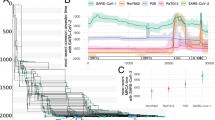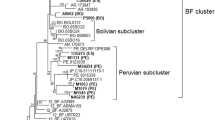Abstract
The CRF04_cpx strains of HIV-1 accounts for approximately 2–10% of the infected population in Greece, across different transmission risk groups. CRF04_cpx was the lineage documented in an HIV-1 transmission network in Thessalonica, northern Greece. Most of the transmissions occurred through unprotected heterosexual contacts between 1989 and 1993. Blood samples were available for six patients, obtained 6–10 years later, except for one patient sampled in 1991. Our objective was to examine whether the transmission history is compatible with the evolutionary tree of the virus, in partial gag, partial env, and partial gag+env. The inferred phylogenetic tree obtained using maximum likelihood and Bayesian methods in partial gag+env was much closer to the transmission tree than that using either env or gag separately. Our findings suggest that the epidemiological relationships among patients who have been infected by a common source correspond almost exactly to the evolutionary trees of the virus, given that enough phylogenetic signal is present in the alignment. Moreover, we found evidence that recombination is not the most parsimonious explanation for the phylogenetic incongruence between gag and env. For patients with known infection dates, the estimated dates of the coalescent events obtained using molecular clock calculations based on a newly developed Bayesian method in gag + env were in agreement with the actual infection dates.



Similar content being viewed by others
References
H Akaike (1973) Information theory as an extension of the maximum likelihood principle F Petrov BN Csaki (Eds) Second International Symposium on Information Theory Akademiai Kiado Budapest 267–281
J Albert J Wahlberg T Leitner D Escanilla M Uhlén (1994) ArticleTitleAnalysis of a rape case by direct sequencing of the human immunodeficiency virus type 1 pol and gag genes J Virol 68 5918–5924
A Blanchard S Ferris S Chamaret D Guetard L Montaner (1998) ArticleTitleMolecular evidence for nosocomial transmission of human immunodeficiency virus from a surgeon to one of his patients J Virol 72 4537–4540
RW DeBry LG Abele SH Weiss MD Hill M Bouzas E Lorenzo F Graebnitz L Resnick (1993) ArticleTitleDental HIV transmission? Nature 361 691
CJ Douady F Delsuc Y Boucher WF Doolittle EJ Douzery (2003) ArticleTitleComparison of bayesian and maximum likelihood bootstrap measures of phylogenetic reliability Mol Biol Evol 20 248–254
Drummond AJ, Rambaut A (2003) BEAST v1.0; available from http://evolve.zoo.ox.ac.uk/beast/
AJ Drummond GK Nicholls AG Rodrigo W Solomon (2002) ArticleTitleEstimating mutation parameters, population history and genealogy simultaneously from temporally spaced sequence data Genetics 161 1307–1320
F Gao DL Robertson CD Carruthers Y Li E Bailes LG Kostrikis MO Salminen F Bibollet-Ruche M Peeters DD Ho GM Shaw PM Sharp BH Hahn (1998) ArticleTitleAn isolate of human immunodeficiency virus type I represents a complex mosaic comprising three different group M subtypes (A, G, and I) J Virol 72 10234–10241
DM Hillis JP Huelsenbeck (1994) ArticleTitleSupport for dental HIV transmission Nature 369 24–25
EC Holmes LQ Zhang P Simmonds AS Rogers AJ Leigh Brown (1993) ArticleTitleMolecular investigation of human immunodeficiency virus (HIV) infection in a patient of an HIV-infected surgeon J Infect Dis 167 1411–1414
EC Holmes LQ Zhang P Robertson A Cleland E Harvey P Simmonds AJL Brown (1995) ArticleTitleThe molecular epidemiology of human immunodeficiency virus type 1 in Edinburgh J Infect Dis 171 45–53
JP Huelsenbeck F Ronquist R Nielsen JP Bollback (2001) ArticleTitleBayesian inference of phylogeny and its impact on evolutionary biology Science 294 2310–2314
B Korber M Muldoon J Theiler F Gao R Gupta A Lapedes BH Hahn S Wolinsky T Bhattacharya (2000) ArticleTitleTiming the ancestor of the HIV-1 pandemic strains Science 288 1789–1796
LG Kostrikis E Bagdades Y Cao L Zhang D Dimitriou DD Ho (1995) ArticleTitleGenetic analysis of human immunodeficiency virus type 1 strains from patients in Cyprus: Identification of a new subtype designated subtype I J Virol 69 6122–6130
T Leitner J Albert (1996) ArticleTitleAccurate reconstruction of a known HIV-1 transmission history by phylogenetic tree analysis Proc Natl Acd Sci USA 93 10864–10869
T Leitner J Albert (1999) ArticleTitleThe molecular clock of HIV-1 unveiled through analysis of a known transmission history Proc Natl Acd Sci USA 96 10752–10757
T Leitner W Fitch (1999) The phylogenetics of known transmission histories KA Crandall (Eds) The evolution of HIV Johns Hopkins University Press Baltimore, Maryland 315–345
T Leitner S Kumar J Albert (1997) ArticleTitleTempo and mode of nucleotide substitutions in gag and env gene fragments in human immunodeficiency virus type 1 populations with a known transmission history J Virol 71 4761–4770
ML Metzker DP Mindell XM Liu RG Ptak RA Gibbs DM Hillis (2002) ArticleTitleMolecular evidence of HIV-1 transmission in a criminal case Proc Natl Acad Sci USA 99 14292–14297
G Nasioulas D Paraskevis E Magiorkinis M Theodoridou A Hatzakis (1999) ArticleTitleMolecular analysis of the full-length genome of the HIV-1 “Subtype I”: evidence of triple recombination AIDS Res Hum Retroviruses 15 745–758
CY Ou CA Ciesielski G Myers et al. (1992) ArticleTitleMolecular epidemiology of HIV transmission in a dental practice Science 256 1165–1171
RDM Page (1993) COMPONENT, version 2.0. Biogeography and Conservation Laboratory Natural History Museum London
A Pappa E Papadimitriou A Papoutsi V Kiosses A Antoniadis (2002) ArticleTitleHIV-1 subtypes and circulating recombinant forms (CRFs) in northern Greece Virus Res 85 85–93
D Paraskevis E Magiorkinis M Theodoridou G Mostrou V Papaevangelou VG Kiosses A Hatzakis N Matsaniotis (1999) ArticleTitleMolecular epidemiology of vertical HIV-1 transmission in Greece J Hum Virol 2 339–343
D Paraskevis M Magiorkinis A-M Vandamme LG Kostrikis A Hatzakis (2001) ArticleTitleRe-analysis of human immunodeficiency virus type 1 isolates from Cyprus and Greece, initially designated as ‘subtype I’, reveals a unique complex A/G/H/K/? mosaic pattern J Gen Virol 82 575–580
Paraskevis D, Magiorkinis E, Magiorkinis G, Kiosses VG, Theodoridou M, Paparizos V, Hatzakis A (2002) Molecular epidemiology of the HIV-1 CRF04_cpx initially designated as “subtype I” in Greece. Poster presentation at the XIV International AIDS Conference
D Posada KA Crandall (1998) ArticleTitleMODELTEST: Testing the model of DNA substitution Bioinformatics 14 817–818 Occurrence Handle10.1093/bioinformatics/14.9.817 Occurrence Handle1:CAS:528:DyaK1MXktlCltw%3D%3D Occurrence Handle9918953
A Rambaut (2000) ArticleTitleEstimating the rate of molecular evolution: Incorporating noncontemporaneous sequences into maximum likelihood phylogenies Bioinformatics 16 395–399
DL Robertson JP Anderson JA Bradac JK Carr B Foley RK Funkhouser F Gao BH Hahn ML Kalish C Kuiken GH Learn T Leitner F McCutchan S Osmanov M Peeters D Pieniazek M Salminen PM Sharp S Wolinsky B Korber (2000) ArticleTitleHIV-1 nomenclature proposal Science 288 55–56
M Salemi K Strimmer WW Hall M Duffy E Delaporte S Mboup M Peeters A-M Vandamme (2001) ArticleTitleDating the common ancestor of SIVcpz and HIV-1 group M and the origin of HIV-1 subtypes using a new method to uncover clock-like molecular evolution FASEB J 15 276–278
R Shankarappa JB Margolick SJ Gange AG Rodrigo D Upchurch H Farzadegan P Gupta CR Rinaldo GH Learn X He XL Huang JI Mullins (1999) ArticleTitleConsistent viral evolutionary changes associated with the progression of human immunodeficiency virus type 1 infection J Virol 73 10489–10502
H Shimodaira M Hasegawa (2001) ArticleTitleCONSEL: For assessing the confidence of phylogenetic tree selection Bioinformatics 17 1246–1247 Occurrence Handle10.1093/bioinformatics/17.12.1246 Occurrence Handle1:STN:280:DC%2BD38%2FgtFOlsw%3D%3D Occurrence Handle11751242
H Shimodaira (2000) Another calculation of the p-value for the problem of regions using the scaled bootstrap resamplings. Technical Report No. 2000-2035 Stanford University Palo Alto, CA
Y Suzuki GV Glazko M Nei (2002) ArticleTitleOvercredibility of molecular phylogenies obtained by Baeysian phylogenetics Proc Natl Acd Sci USA 99 16138–16143
DL Swofford (1998) PAUP*. Phylogenetic Analysis Using Parsimony (*and other methods), Version 4 Sinauer Associates Sunderland, MA
JD Thompson DG Higgins TJ Gibson (1994) ArticleTitleCLUSTAL W: Improving the sensitivity of progressive multiple sequence alignment through sequence weighting, position-specific gap penalties and weight matrix choice Nucleic Acids Res 22 4673–4680 Occurrence Handle1:CAS:528:DyaK2MXitlSgu74%3D Occurrence Handle7984417
LA Whittingham B Slikas DW Winkler FH Sheldon (2002) ArticleTitlePhylogeny of the tree swallow genus, Tachycineta (Aves: Hirundinidae), by Bayesian analysis of mitochondrial DNA sequences Mol Phylogenet Evol 22 430–441
Z Yang (1997) ArticleTitlePAML: A program package for phylogenetic analysis by maximum likelihood Comput Appl Biosci 13 555–556 Occurrence Handle1:CAS:528:DyaK2sXntlGnu7s%3D Occurrence Handle9367129
Acknowledgments
We wish to acknowledge Jan Albert and Tomas Leitner for their supportive comments and suggestions about this study and Constantinos-Simos Nistiotis for statistical advice. D.P. was supported by a Marie Curie fellowship from the European Commission (QLK2-CT2001-51062) and by the Hellenic Center for Infectious Disease Control (KEEL). P.L. was supported by the Flemish Institute for Scientific-Technological Research in Industry (IWT). This work was supported by the Hellenic Scientific Society for the Study of AIDS and Sexually Transmitted Diseases and in part by the Flemish Fonds voor Wetenschappelijk Onderzoek (FWO G.0288.01).
Author information
Authors and Affiliations
Corresponding author
Additional information
Reviewing Editor: Dr. Lauren Ancel-Meyers
Isolated sequences from patients belonging to the CRF04_cpx transmission network always correspond to partially characterized gag, env, and gag+env genomic regions.
Appendix
Rights and permissions
About this article
Cite this article
Paraskevis, D., Magiorkinis, E., Magiorkinis, G. et al. Phylogenetic Reconstruction of a Known HIV-1 CRF04_cpx Transmission Network Using Maximum Likelihood and Bayesian Methods. J Mol Evol 59, 709–717 (2004). https://doi.org/10.1007/s00239-004-2651-6
Received:
Accepted:
Issue Date:
DOI: https://doi.org/10.1007/s00239-004-2651-6




